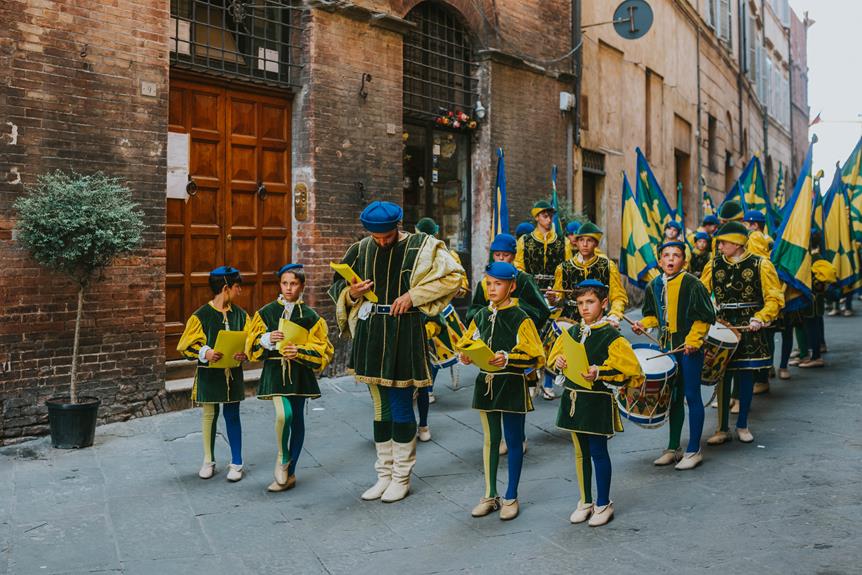
As a lover of culture and vibrant festivities, I've had the privilege of witnessing the breathtaking array of traditional costumes at cultural festivals in Spain. From the fiery Flamenco dresses that exude passion to the ornate Basque traditional attire that showcases rich heritage, each ensemble tells a captivating story. Whether it's the Valencian Fallas costumes, Andalusian Feria outfits, or the charming Catalan Sardana clothing, these costumes are a testament to Spain's deep-rooted traditions and the pride of its people. Join me on a journey through the top traditional costumes at these mesmerizing cultural celebrations.
Key Takeaways
Table of Contents
- Flamenco dresses and Andalusian Feria outfits are traditional costumes worn by women in Andalusia during flamenco dances and cultural festivals.
- Basque traditional attire reflects the cultural heritage of the Basque region and is characterized by white shirts, red neckerchiefs, black berets, and vibrant layered skirts for women.
- Valencian Fallas costumes showcase the cultural heritage of Valencia with elaborate dresses for women and traditional suits for men, each element symbolizing different aspects of Valencian life.
- Catalan Sardana clothing, consisting of a white shirt, black trousers, and a red sash, is deeply rooted in Catalan culture and is worn during the symbolic Sardana dance, representing unity and togetherness.
Flamenco Dresses
When I attended cultural festivals in Spain, I was captivated by the vibrant and intricate designs of flamenco dresses. These dresses have a rich history that dates back several centuries. Originally, flamenco dresses were worn by women in Andalusia, a region in southern Spain, as they danced the traditional flamenco dance. The dresses were designed to accentuate the movements of the dancers, with their long, flowing skirts and fitted bodices. Over time, the flamenco dress has become an iconic symbol of Spanish culture and has influenced modern fashion trends. Today, you can see elements of flamenco dresses in contemporary designs, such as ruffled sleeves and flared skirts. The influence of flamenco dresses on modern fashion is a testament to their enduring beauty and timeless appeal.
Basque Traditional Attire
As I explored the cultural festivals in Spain, I couldn't help but admire the distinctive and captivating Basque traditional attire. The Basque people take great pride in their unique and colorful costumes, which reflect their rich cultural heritage. The men don white shirts with red neckerchiefs, black berets, and black pants, while the women wear vibrant, layered skirts with intricate patterns and matching blouses. The traditional attire is often adorned with beautiful embroidery and accessories like belts, earrings, and necklaces. During Basque traditional dances, such as the jota or the fandango, the costumes come to life, adding to the lively and energetic atmosphere. The melodies of Basque traditional music resonate with the vibrant colors and intricate designs of the attire, creating a visually stunning and culturally rich experience.
Valencian Fallas Costumes
I love witnessing the vibrant Valencian Fallas costumes during cultural festivals in Spain. The Valencian Fallas traditions have a rich history that dates back centuries. These costumes are an integral part of the Fallas festival, which is celebrated in Valencia every March. Here are some fascinating aspects of Valencian Fallas costumes:
- Traditional attire: The costumes worn during Fallas are based on traditional Valencian clothing, showcasing the region's cultural heritage.
- Elaborate dresses: Women wear stunning, long dresses with intricate designs and vibrant colors, adorned with jewelry and accessories.
- Men's outfits: Men don traditional Valencian suits, consisting of white shirts, waistcoats, and trousers, paired with a traditional handkerchief tied around the neck.
- Regional pride: These costumes reflect the pride Valencians have for their heritage and are a way to showcase their unique culture to the world.
- Symbolism: Each costume element has its symbolism, representing different aspects of Valencian life and history.
The Valencian Fallas costumes are a visual feast and a testament to the rich traditions and history of the region.
Andalusian Feria Outfits
One popular traditional costume at cultural festivals in Spain is the number of Andalusian Feria outfits. Andalusian Feria fashion trends are characterized by vibrant colors, intricate designs, and flowing fabrics. Women often wear flamenco-inspired dresses, known as "trajes de flamenca," which feature ruffled sleeves, fitted bodices, and tiered skirts. These dresses come in a variety of colors and patterns, from bold polka dots to delicate floral prints. Iconic accessories for Andalusian Feria outfits include the mantilla, a lace veil worn over the hair, and the peineta, a decorative comb that holds the mantilla in place. Women also adorn themselves with large, ornate earrings, colorful shawls, and flower crowns. Men typically wear tailored suits in light colors, paired with wide-brimmed hats and traditional leather boots. Overall, Andalusian Feria outfits capture the spirit of celebration and elegance at cultural festivals in Spain.
Catalan Sardana Clothing
Continuing with the discussion on traditional costumes at cultural festivals in Spain, another noteworthy attire is the Catalan Sardana clothing. This attire holds significant historical significance and has seen modern adaptations over the years. Here are five key aspects of the Catalan Sardana clothing:
- Historical significance: The Catalan Sardana clothing is deeply rooted in Catalan culture and heritage, dating back centuries.
- Traditional elements: The attire typically consists of a white shirt, black trousers, and a red sash tied around the waist.
- Modern adaptations: While the basic elements remain the same, modern adaptations have introduced variations in colors and designs to make the attire more vibrant and appealing.
- Symbol of unity: The Sardana dance, performed while wearing this attire, is a symbol of unity and togetherness among the Catalan people.
- Cultural pride: Wearing Catalan Sardana clothing during festivals and events is a way for the locals to express their cultural pride and celebrate their heritage.
The Catalan Sardana clothing is a beautiful representation of Catalan history and traditions, blending the old and the new to create a unique and cherished attire.
Frequently Asked Questions
What Is the History Behind the Flamenco Dress and How Has It Evolved Over Time?
The history of the flamenco dress dates back centuries and has evolved over time. Its vibrant colors, ruffled sleeves, and fitted silhouette are iconic. The dress represents the cultural significance of flamenco attire and is a symbol of Spanish tradition and expression.
Are There Any Specific Rules or Etiquette Associated With Wearing Basque Traditional Attire?
I'm not sure about specific rules or etiquette for wearing Basque traditional attire, but I can tell you that the significance of symbolic elements in Andalusian Feria outfits is quite fascinating.
What Materials Are Commonly Used to Make Valencian Fallas Costumes and Why?
Valencian fallas costumes are made from materials like silk, velvet, and lace. These materials are chosen for their beauty and elegance, adding to the significance of the costumes worn during the festival.
Are There Any Symbolic Elements or Colors Incorporated in Andalusian Feria Outfits?
In Andalusian feria outfits, there are various symbolic elements incorporated that represent the rich cultural heritage. The importance of colors in these costumes adds vibrancy and expresses the festive spirit.
How Is Catalan Sardana Clothing Different From Traditional Attire in Other Regions of Spain?
Catalan sardana clothing differs from traditional attire in other regions of Spain due to its unique design and cultural significance. Andalusian feria outfits, influenced by Moorish culture, incorporate symbolic elements and vibrant colors.




Leave a Reply
You must be logged in to post a comment.